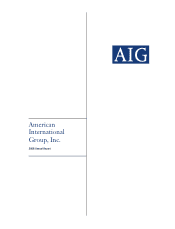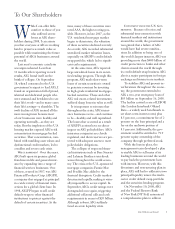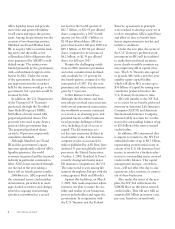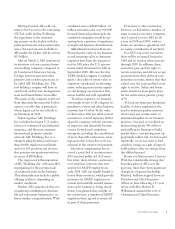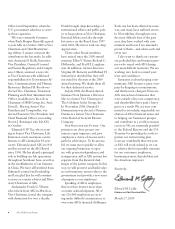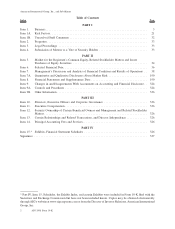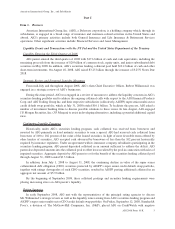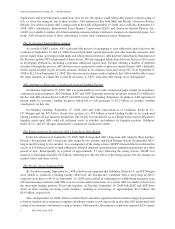AIG 2008 Annual Report Download - page 4
Download and view the complete annual report
Please find page 4 of the 2008 AIG annual report below. You can navigate through the pages in the report by either clicking on the pages listed below, or by using the keyword search tool below to find specific information within the annual report.2 AIG 2008 Annual Report
AIG’s liquidity issues and provide
more time and greater exibility
to sell assets and repay the govern-
ment. Among the provisions was the
creation of two nancing entities,
Maiden Lane II and Maiden Lane
III, to acquire AIG’s securities lend-
ing assets and the multi-sector
collateralized debt obligations that
were guaranteed by AIGFP’s credit
default swaps. The entities were
funded primarily by the government,
with a subordinated capital contri-
bution by AIG. Under the terms
of the agreements, the majority of
any appreciation in the securities
held by the entities would go to the
government, but a portion would be
retained by AIG.
In addition, the U.S. Department
of the Treasury (U.S. Treasury)
purchased, through the Troubled
Asset Relief Program (TARP),
$40 billion of newly issued AIG
perpetual preferred shares. The
proceeds were used to pay down a
portion of the government loan.
The perpetual preferred shares
carried a 10 percent coupon with
cumulative dividends.
Although Maiden Lane II and
III and the government’s equity
injection signi cantly relieved AIG’s
liquidity pressures, the world
economy in general and the nancial
industry in particular continued to
falter. AIG’s losses mounted through-
out the end of the year, taking a
heavy toll on fourth quarter results.
2008 RESULTS. AIG reported that
the continued severe credit market
deterioration, particularly in mort-
gage-backed securities, and charges
related to ongoing restructuring
activities, contributed to a record
net loss for the fourth quarter of
$61.7 billion, or $22.95 per diluted
share, compared to a 2007 fourth
quarter net loss of $5.3 billion, or
$2.08 per diluted share. AIG’s re-
ported net loss for full year 2008 was
$99.3 billion, or $37.84 per diluted
share, compared to net income of
$6.2 billion, or $2.39 per diluted
share, for full year 2007.
Despite the challenging condi-
tions in 2008, insurance premiums
and other considerations declined
only modestly by 1.9 percent for
the fourth quarter, compared to the
same period of 2007. For the year,
premiums and other considerations
grew by 5.3 percent.
A NEW RESTRUCTURING PLAN.
Although the divestiture and busi-
ness sale process had some successes
with several announced transactions,
the worldwide economy continued
to worsen at an alarming pace, and
potential buyers of AIG businesses
faced growing challenges of their
own, including a lack of access to
capital. The life insurance sec-
tor has seen enormous declines in
stock market value. Life insurance
company stocks, as measured by
indices published by A.M. Best, have
declined 51 percent globally and 60
percent in the United States since
October 1, 2008. Standard & Poor’s
recently downgraded many major
life insurance companies in the U.S.
The same trend is seen among life
insurers throughout Europe with the
rating agencies Fitch and Moody’s.
Against this backdrop, on March
2, 2009, AIG made important adjust-
ments in our plan to assure the sta-
bility and vitality of our businesses,
protect policyholders and repay the
government. In cooperation with
the U.S. Treasury and the Federal
Reserve, agreements in principle
were reached to develop a new set of
tools to strengthen AIG’s capital base
and allow us time to bene t from
future improvements in market and
industry conditions.
Under the new plan, the terms of
the U.S. Treasury’s preferred stock
investment in AIG will be modi ed
to make these preferred securities
more closely resemble common eq-
uity, improving AIG’s capital struc-
ture. The U.S. Treasury also agreed
to provide AIG with a new ve-year
standby equity capital facility,
which will allow AIG to raise up to
$30 billion of capital by issuing non-
cumulative preferred stock to the
U.S. Treasury from time to time.
AIG will transfer to the NY Fed,
or to a trust for its bene t, preferred
interests in American Life Insurance
Company (ALICO) and American
International Assurance Company,
Limited (AIA) in return for a reduc-
tion in the outstanding balance of up
to $26 billion of the senior secured
credit facility.
In addition, AIG announced that
it expects to transfer to the NY Fed
embedded value of up to $8.5 billion,
representing securitization notes of
certain of its U.S. life insurance busi-
nesses, in return for a further reduc-
tion in its outstanding senior secured
credit facility balance. This capital
management strategy—securitiza-
tion—will not affect the day-to-day
operations, sales activities or custom-
ers of these businesses.
Also, under the terms of the new
plan, the NY Fed will remove the
LIBOR oor on the senior secured
credit facility. This will save AIG an
estimated $1 billion in interest costs
per year, based on current levels.

